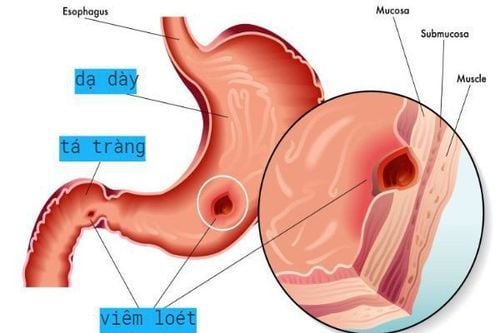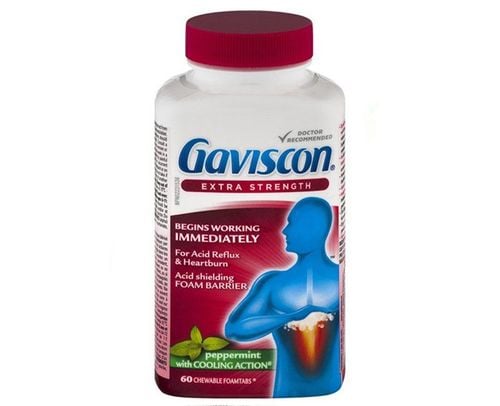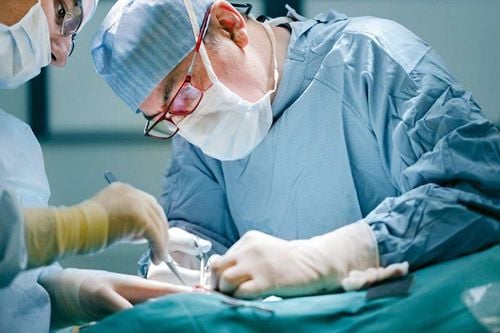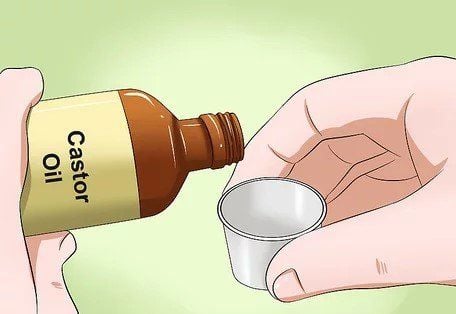This is an automatically translated article.
The article is professionally consulted by Gastroenterologist, Department of Examination & Internal Medicine - Vinmec Hai Phong International General Hospital and Master. BSCK II Phan Thi Minh Huong - Gastroenterologist - Department of Medical Examination & Internal Medicine - Vinmec Da Nang International General Hospital.Stomach pain often causes a lot of inconvenience in life for patients. Today, this disease is becoming more and more common. Although stomach pain is not life-threatening, it causes many symptoms such as nausea, acid reflux, heartburn, belching, etc., which seriously affects the quality of life. of the patient.
1. What are stomach aches?
Stomach pain occurs because the stomach lining of the patient is damaged and is not treated in time, leading to an ulcer. Patients with stomach pain will experience stomach pain for a long time, often appearing at night or early in the morning, causing many difficulties in the patient's daily activities.According to research, stomach pain is often recorded as a pain appearing in 3 specific areas of the body, namely the middle abdomen, the upper left abdomen and the most characteristic area is the epigastrium (which is the upper left abdomen). belly above navel).
In addition to suffering from pain and inconvenience in life, patients with stomach pain, if not diagnosed and treated promptly, will suffer extremely dangerous complications, such as stomach cancer. and directly affect the quality of life of patients.

Đau dạ dày xảy ra khi niêm mạc dạ dày bị tổn thương lâu ngày
2. Frequent, persistent stomach pain is a warning of what diseases?
Patients with persistent stomach pain, often repeated for a long time, is a warning from the body, this is a sign of dangerous diseases related to the digestive system such as:2.1 Ulcers Stomach and duodenal bulb This is a disease that often occurs when the patient's stomach and duodenal bulb is having an ulcer. The main cause of this phenomenon is believed to be caused by the bacteria Helicobacter pylori (H.P. bacteria) or by the patient using excessive amounts of non-steroidal anti-inflammatory drugs (NSAIDs).
The following are typical symptoms of gastric ulcer, duodenal ulcer:
The patient has bloating, nausea, and indigestion. Frequent stomach pain around the abdomen above the navel (also known as the epigastrium). Heartburn, belching or burning in the epigastrium. Not sleeping well, often insomnia, this condition occurs because the patient's stomach always feels uncomfortable and painful, causing the patient's sleep to be interrupted. Patients with gastrointestinal disorders, the most common symptoms include constipation, diarrhea, abdominal bloating. Stomach pains often appear when the patient is hungry, the most common time is after a meal about 2-3 hours, but the patient can have pain in the middle of the night, or early in the morning. These pains are usually only dull, abdominal pain, sometimes can turn into intermittent cramps.

Người bệnh thường có dấu hiệu đau quặn bụng vào đêm hoặc rạng sáng
The most dangerous complications of the disease are summed up including:
Hemorrhage (ie bleeding from ulcers from the stomach, duodenal bulb): this is the most common complication today, there are about 15-20 % of patients with peptic ulcer will have one or more bleeding episodes, usually the elderly will have a higher rate of gastric bleeding than the young. Ulcerative complications may signal the first signs or occur during episodes of advanced ulceration. Perforation or fistulas : this is considered a second complication, appearing after the symptoms of stomach bleeding, starting with severe pain like being stabbed by a knife. Pyloric stenosis: common due to duodenal ulcer causing deformation of the duodenal bulb, prepyloric tumor or antrum, patients often present with pain in the epigastric region, vomiting food and food. old eat. Carcinoma: the rate of cancer is about 5-10% and then the duration of gastric ulcer has lasted >10 years. 2.2 Stomach cancer Approximately 25% of gastric cancer patients have a history of peptic ulcers. Usually progresses from chronic gastritis to chronic atrophic gastritis, intestinal metaplasia, dysplasia and eventually adenocarcinoma.
Risk factors: Helicobacter Pylori bacteria, salty diet or eating foods preserved with salt, smoking, alcohol, ...
Common signs:
Pain in the epigastric region (located above the navel ) at first mild, vague pain, but more and more pain as the disease progresses Feeling of nausea and vomiting, or loss of appetite, quickly full As the condition becomes more severe, the patient will feel sick pain both when full and hungry, the body becomes thin, the skin begins to turn pale, always feel tired, may vomit blood, defecate black. There may be signs or symptoms of distant metastasis. Common locations liver, peritoneum, lymph nodes, ...

Hang vị bị viêm loét nặng khiến người bệnh luôn cảm thấy mệt mỏi
Please dial HOTLINE for more information or register for an appointment HERE. Download MyVinmec app to make appointments faster and to manage your bookings easily.













